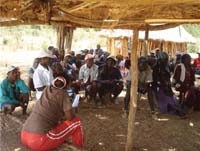11.3.2 Group functions
In most groups you will be able to see that there are three important group functions: group building, group maintenance and task maintenance.
Group building functions
At the start of any group there are many possible ways in which it could be established. For appropriate group building you may have to consider the selection of group members and how the individual members should be recruited. Before the group starts you will have to arrange the physical environment and provide any necessary equipment. When people first arrive for the group meeting you should attend to the introduction of members to each other, before electing a leader and reporter (or note taker) for the group. At the first session it is really important to make clear what the functions of the group will be, and explain the purpose and goals of the group in the future.
Group maintenance functions
To keep the group running smoothly it is important to use encouraging words towards the group members. You might say, ‘Your suggestions are very important’. If tensions arise you may have a role in mediating or making compromises to help the functioning of the group. In relieving tension it may be appropriate to lighten the discussion by talking about things on which there is agreement — or even making jokes if this is appropriate. If some people dominate the group you may have to take a little more control and ensure that every member of the group can have their voice heard.
Task maintenance functions
To keep a group running smoothly and making progress towards its objectives there are many different functions that you should consider. You may have to initiate things within the group and bring new ideas and creativity to the sessions, or invite other group members to do this. Leaders of a group should also be able to look for information from different sources, including from other group members. It may be necessary to clarify or elaborate on specific issues as the group progresses. Throughout the group sessions it will be important to coordinate its activities and summarise how much progress has been made at the end of each group session.
Think again about the group you used as an example in the previous activity. What were each of these functions for that group?
Did you think about the physical setting of the group? Did that work well? And was there a clear message at the beginning of the group about what the goals of the group were? How were the workings of the group controlled? Were people’s contributions valued? Was the progress of the group remarked on? Did people know where they had got to?
Of course, not all group work goes smoothly (Figure 11.7)!

Conflict resolution
Disagreement as a result of differences in opinions and views on issues is a frequent occurrence in groups. Sometimes it may be useful to think about how differences or conflicts could be resolved in any groups that you are responsible for running. Successful groups have conflict resolution mechanisms, both formal and informal, for dealing with differences — otherwise the disagreements could lead to poor group interactions or poor performance, or the group disbanding altogether.
No two groups are the same and this is the interesting thing about establishing various groups for your health education activities. You will soon become experienced in handling groups and using them to improve the health of your community. Each individual will bring something important to the group and it is your role to make the best of the contributions that everyone is able to make. However not everyone behaves in the same way when they are members of a group, as Box 11.5 illustrates.
Box. 11.5 Types of group behaviour
Helpful behaviour:
Making suggestions, encouraging each other to talk, responding politely to the suggestions of others, helping make points clear, giving information, showing concern for each other, volunteering to help with work, attending meetings regularly and on time, and thanking each other for suggestions given.
Non-helpful, non-functional behaviours:
- Blocking: interfering with group process, diverting attention by citing personal experiences unrelated to the problem, disagreeing and opposing a point without reason. Arguing too much on a point that the rest of the group has resolved and rejecting ideas and preventing a decision.
- Aggression: blaming others, showing hostility.
- Seeking recognition: calling attention to oneself by excessive talking and boasting.
- Withdrawing: becoming indifferent or passive and whispering to others.
- Dominating: excessive manipulation or authority and interrupting or undermining the contribution of others.
Some identifiable types of behaviour are set out in Box 11.5. Read carefully through the material in the box and think back to groups that you have been a member of. Can you think of specific people who have behaved in the ways detailed in the box? How do you behave yourself when you are a member of a group?
We cannot know what happened in your group, but as a Health Extension Practitioner you must become skilled at encouraging helpful behaviours and at controlling unhelpful behaviours. Observing groups is an important component in learning and maintaining these skills.
11.3.1 Group dynamics
